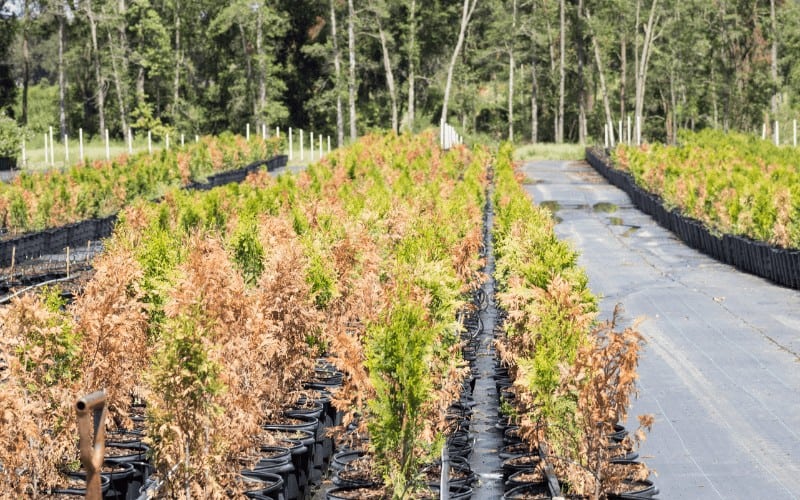Being a rookie in the gardening field means you will make some mistakes. One of those mistakes is overwatering your plant.
Before growing a plant, you must do some research. While some plants thrive with many doses of water, some plants will thrive better with little water.
Wilting, soft or puffy leaves and stems, brown foliage, and so much more are signs of an overwatered plant.
Watching your plant die due to watering is not exactly a pretty sight to behold. But, how do you bring a plant back to life after overwatering? The first step is to stop watering your plant temporarily and improve drainage.
Now, let's look at how to fix your overwatered plants and bring them back to life.
Table of Contents
How to Identify an Overwatered Plant
Overwatered and underwatered plants share certain similarities. Thus, you need to know the difference between an overwatered and underwatered plant.
One of the most telling signs of an overwatered plant is soggy soil. Other common symptoms of an overwatered plant are outlined below:
- Wilting
- Soft or puffy leaves and stems
- Brown spots on leaves and leaf tips
- Slow growth and stunting
- Leaves turning a lighter green color
- Yellowing or brown foliage
How Do You Bring A Plant Back to Life After Overwatering?

Overwatering is more common with potted plants because the water is retained in the pot or gallon and can’t drain away from the roots. Sometimes, poor potting soil can cause overwatering.
When you notice symptoms of an overwatered plant and do nothing about it, your plant might die. Luckily, there are various steps you can take to revive an overwatered plant.
1. Dry Out the Plant
If the potting soil is quite soggy, it means that your plant is overwatered. The first step is to stop overwatering the plant.
Otherwise, the problem will continue to get worse. Make sure the soil and roots are dry before watering again. It may take several days for the plant to dry out.
2. Place the Plant in The Shade With Indirect Sunlight
Most gardeners mistake placing their overwatered plant under direct sunlight; this practice may be harmful to the plant.
Overwatered plants have trouble transporting water to their upper extremities and, thus, will dry out if it's left under the sun. Bring the plant into a shade and take it out once the plant has stabilized.
3. Use Your Hands or A Shovel to Loosen the Soil
Loosening the soil will create air pockets that will help your roots dry. To loosen the soil, use your hands or a small shovel to tap the sides of the pot.
4. Prune Away Brown, Stinky Roots with Pruning Shears Or Scissors
Once you have identified healthy roots from the unhealthy ones, the next step is to cut out the rotting roots. The rooting roots are soft and look brown or black.
Pruning shears or scissors are the best tools to trim out the rooting roots. However, if all the roots are rotten, you may have to discard the plant.
5. Trim Away Dead Leaves and Stems Using Pruning Shears Or Scissors
Using pruning shears or scissors, trim out the unhealthy leaves and stems. Unhealthy stems are usually brown and soft while the leaves are dry.
6. Repot the Plant
Repot the plant by merely transferring it to a pot that has drainage holes and a tray. Your plant may be overwatered because the pot or container doesn't have enough drainage holes on the bottom to let out excess water.
The Right Way to Water Your Dying Plant
If the potting soil is quite soggy, the chances are that you have an overwatered plant in your hand. If soggy soil is accompanied by wilting, yellow leaves, soft and rotten stems, then the chances are that your plant is overwatered.
The first step in saving an overwatered plant is to stop watering the plant thoroughly. Only water the plant when the soil is dry to the touch and light in color.
Remember that each plant requires different amounts of water, so be sure to test each plant individually. Follow the general steps outlined below to water your wilting plant:
- Water the plant by moistening the entire root zone. Don't water the plant from the leaves; target the root region so the water excess water will flow out through the drainage holes.
- Water your plant in the daytime and not at night. Watering your plant at night may breed disease.
- Please don't allow your pot to sit in standing water as it will keep the soil too wet.
Why You Have an Overwatered Plant
Not all cases of overwatered plants are a result of the owner’s mistake or negligence. Sometimes, your plant is easily overwatered for a host of other reasons that will be discussed below:
1. Poorly Draining Soil
Some soils are not ideal for growing plants in pots and containers. A poor draining soil may be the root cause of an overwatered plant.
In this situation, little quantity of water will result in an overwatered plant. To fix poor soil, insert decaying media like pumice, perlite, or coarse sand.
2. Plant Type
As mentioned earlier, different plants have different water needs. It is your duty as a gardener to research the ideal dose of water your plant needs.
If you water all your houseplant equally, you might run into the danger of overwatering a particular plant.
3. Weather
The temperature plays a significant role in how often you water your plant. In summer, water evaporates more quickly, which might require you to water your plant frequently.
4. Pot Material
A terracotta pot is must suited for growing plants. Terracotta’s material is porous enough to allow moisture to escape and the soil to breathe. Also, ensure that your plant has drainage holes.
Related Posts:
- How To Save a Dying Oak Tree
- How to Save A Dying Aloe Plant
- How to Save A Dying Jade Plant
- How Long Does It Take to Bring A Dead Plant Back To Life?
- How To Save a Dying Cherry Tree
Conclusion
Don’t beat yourself up when you have in your hands an overwater plant. Have it in mind that overwatering is not just a beginner’s mistake and can happen to anyone. With practice and experience, you will get the perfect water dosage for your plant.
What happens when you discovered that you had overwatered your plant? How do you bring a plant back to life after overwatering?
Fortunately, your overwatered plant can be salvaged. Don’t give up just yet. The guidelines and steps enumerated in this post will go a long way in bringing your overwatered plant back to life.





